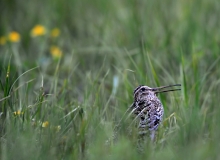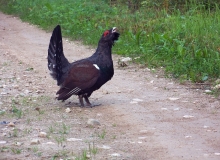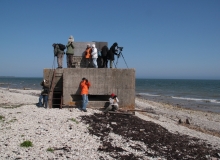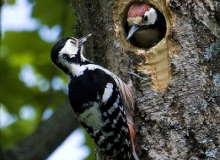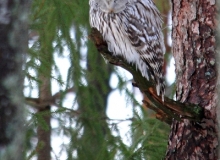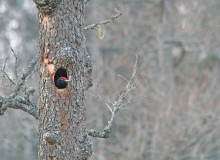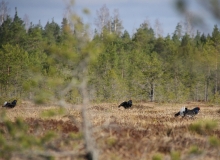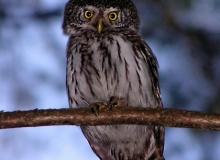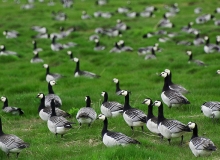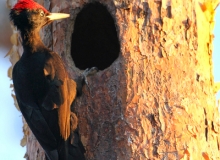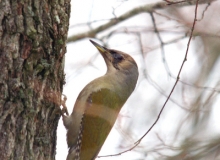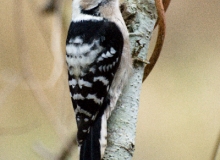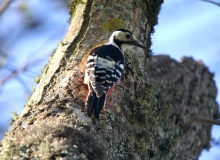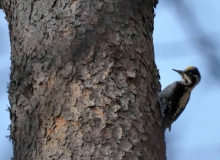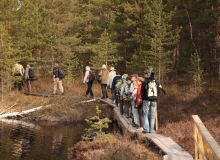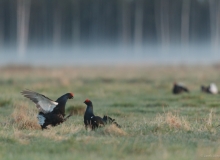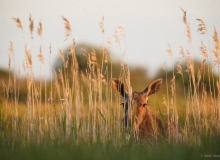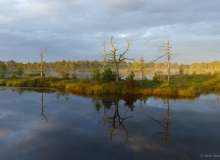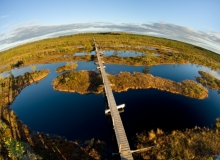Mid-May is the optimal time for bird watching in Estonia – at least if your aim is to see as many bird species as possible. A wide range of species have begun breeding, some are about to leave for the north and each day brings new arrivals. Thousands of swans, hundreds of thousands of ducks and geese, thousands of Scoters and Long-tailed Ducks, myriads of waders and passerines are stopping en route to feed and build up their energy reserves for the long trip to their arctic breeding grounds. This mid-May spectacle, involving millions of waterfowl, is the most massive migration scene in northern Europe.
Usually, the trip yields more than 175 different bird species, many of them rare or absent in Western Europe.
What can you see?
- Huge flocks of Barnacle Geese,
- migrating Ruffs displaying at the meadows,
- migrating Long-tailed Ducks,
- White-tailed Eagle, Lesser Spotted Eagle,
- Black and Hazel Grouse, Capercaillie
- Ural, Pygmy and Tengmalm’s Owls
- White-backed, Three-toed, Grey-headed and Black Woodpeckers
- Thrush Nightingale, Savi’s Warbler, River Warbler, Common Rosefinch and other eastern migrants.
The Estonian spring always offers some unpredictable (and usually pleasant) surprises. It’s not just birds, either! Estonia has healthy populations of Beaver, Brown Bear, Wolf, Lynx, Otter and Elk.
Book a tour with us: info@natourest.ee or by phone: +372 5622 5943
Day 1: Arrival (Tallinn)
We’ll start our trip in North-West Estonia, an area rich in forests and coastal wetlands, for a walk in Marimetsa bog, hoping to see the Black Grouse, Golden plover, Great Grey Shrike and some eagles. Later in the evening, we’ll watch the migration at Põõsaspea peninsula, then spend the night at a lovely resort in Haapsalu. Good birding sites are located all around the hotel.
Day 2: Silma nature reserve near Haapsalu, Nõva landscape reserve, Spithami
Silma reserve is a complex of coastal meadows, lagoons and reedbeds with lots of ducks, some Slavonian and Red-necked Grebes, Goose, Cranes, Penduline and Bearded Tits. The Nõva forests welcome the Capercaillie, Hazel Grouse and Nightjar.
Day 3: Matsalu National Park
Birds by the thousands await us at this most famous wetland complex in Estonia, with vast spaces of coastal and alluvial (and some wooded) meadows and reed-beds making it a prime stopover location. By the time of the tour, tens of thousands of Barnacle Geese should be present, sometimes accompanied by a few Red-breasted Geese. Birders have recorded 170 species of birds breeding in the reserve, among them the Bittern, Osprey, Lesser Spotted and White-tailed Eagle and Caspian Tern. Moving to the south in the evening, we’ll visit Audru wetlands, hoping to see more flocks of geese.
Day 4: Soometsa-Rannametsa nature reserves, Pikla fish ponds
This large combined reserve close to Latvian border, with lots of coniferous forests, heathland and wetland habitats, offers both coastal and forest bird species. Pikla fish ponds should reveal more ducks, waders, raptors and reedbed species like Savi’s and Great Reed Warblers and Bitterns.
Day 5: Kabli bird station, Nigula bog, evening at Väike-Rakke wetland (Võrtsjärv)
Kabli Bird Station is one of the best migration watchpoints in the area. We should see some passerines streaming through and migrating waders and ducks on the shoreline. Walking through Nigula, a protected peat bog could yield Black Stork, Black Grouse, Capercaillie, Lesser Spotted Eagle, Ural Owl Great Grey Shrikes, Common Crane, Wood Sandpiper, Greenshank or Whimbrel. The boardwalks will lead us to a bog-island where an old forest provides breeding grounds for White-backed Woodpecker and Red-Breasted Flycatchers. In the evening, we’ll travel north to Väike-Rakke polder, a wetland area at Võrtsjärv, Estonia’s second largest lake, which teems with ducks, geese and waders during migration time.
Day 6: Tartu, Alam (Lower)-Pedja Nature Reserve
Vast Alam-Pedja reserve may surprise us with the sight of the Spotted Eagle, breeding here along with many pairs of Lesser Spotted Eagles. We’re also likely to spot a number of woodpecker species, along with Ural Owl and Nightjar. A highlight of the trip awaits: the Great Snipe lek in the late evening is a sight to behold!
Day 7: Tartu, Aardla polder and Ilmatsalu fish ponds
The marshes of Aardla polder play host to migrant waders and breeding waterfowls: Black Terns, Little Gulls and Red-Breasted Grebes. One highlight of the day will be spotting Citrine Wagtail. The location should also yield Corncrake, Penduline Tits, Common Rosefinch, River and Savi’s Warbler. Migrating Bean and White-fronted geese may still be seen. Citrine Wagtail has become a common sight around Aardla lake. Lush aquatic vegetation of Ilmatsalu’s fishponds attracts the Whooper Swans, Ducks, grebes and Bitterns. Water Rails, Moorhens and Spotted Crakes are common and Little Crake should also be present. In the afternoon we’ll travel back to Tallinn, have a short excursion in Old Town, Estonia’s medieval city centre, and enjoy swapping notes about our “finds” over dinner in a nice restaurant.
Day 8: Departure from Tallinn
Book a tour with us: info@natourest.ee or by phone: +372 5622 5943
Price for self-guided tour with a smart device
is 750 Eur per person with a group of 2 people. Price includes:
- 7 nights in local hotels and guesthouses (twin rooms with toilet and shower; breakfasts included),
- 8 days smart device rent (usually Huawei MediaTab)
- Self-guided map,
- 8 days car rental,
- Estonian road atlas.
Prices for guided groups
Price includes bird guide services for 8 days, 7 nights in local hotels and guesthouses (twin rooms with toilet and shower), local transport, breakfast, lunch and dinner each day.
- 2 people: 2050 EUR per person
- 3-4 people: 1550 EUR per person
- 5-6 people: 1130 EUR per person
- 7-8 people: 950 EUR per person
- Bigger groups, please ask for special offer
Price includes:
- bird guide services for 8 days,
- 7 nights in local hotels and guesthouses (twin rooms with toilet and shower),
- local transport,
- breakfast, lunch and dinner each day.
Book a tour with us: info@natourest.ee or by phone: +372 5622 5943
Book a tour with us: info@natourest.ee or by phone: +372 5622 5943
Natourest is a travel company registered with the Estonian Ministry of Economic Affairs and Communications and meets all the requirements set by the European Package Travel Directive. This means that when you book a tour through Natourest, your legal and financial rights are guaranteed by the state of Estonia. Read more about the terms and conditions.







